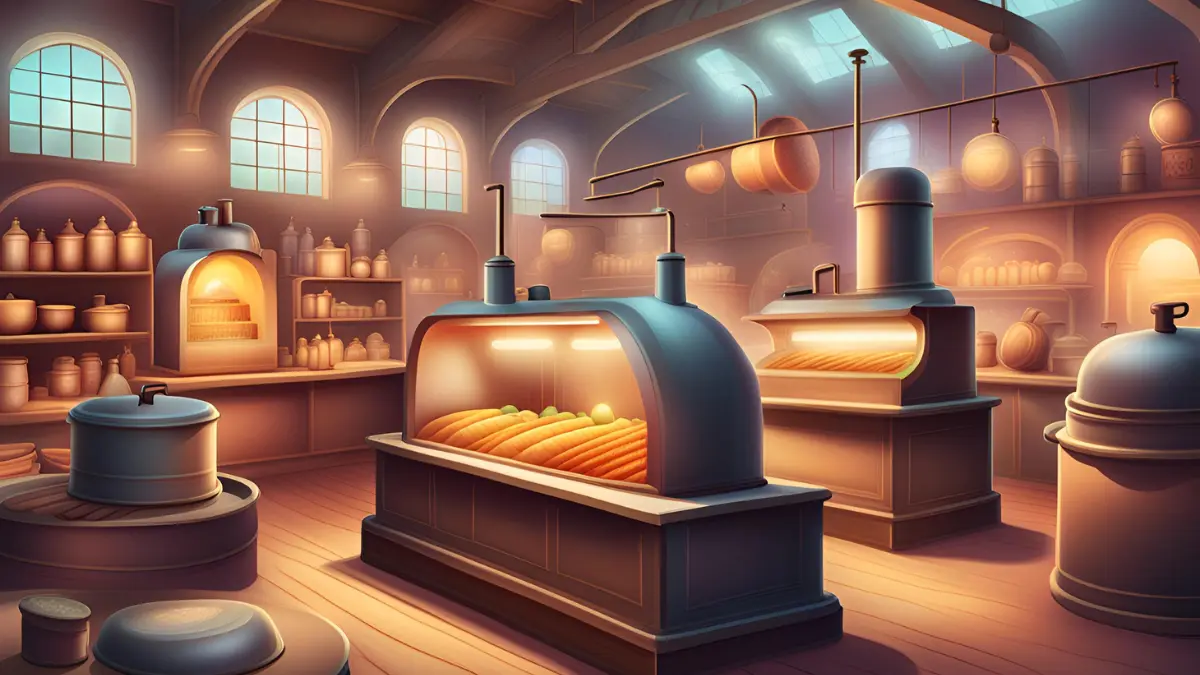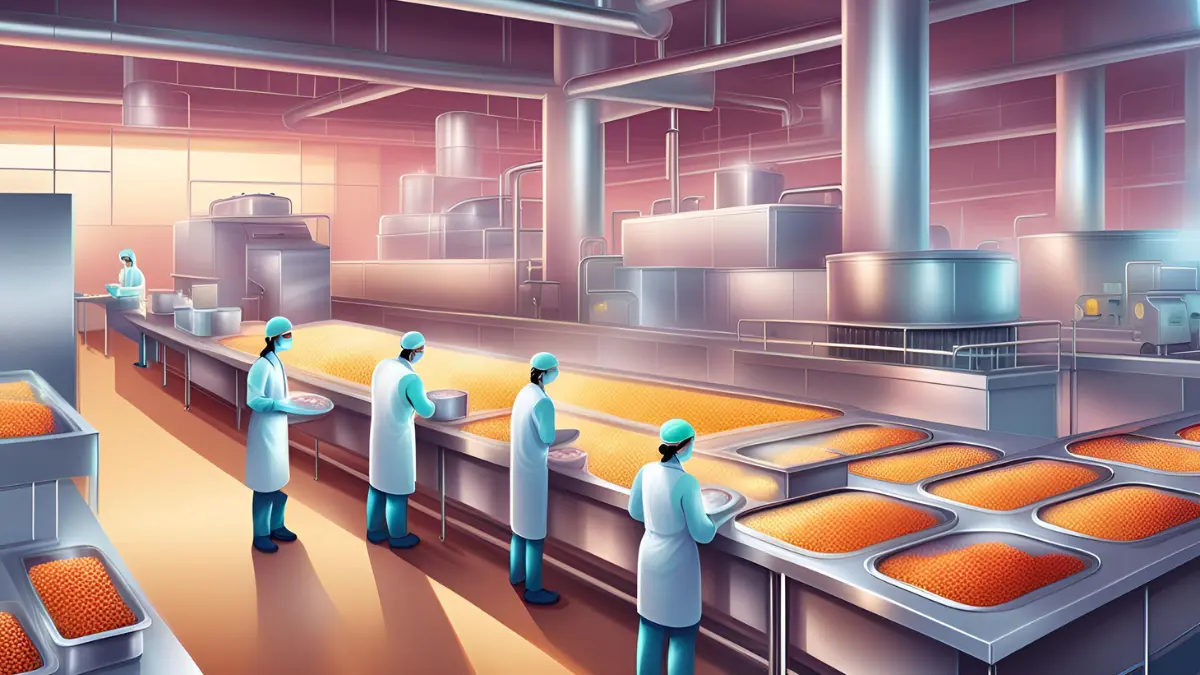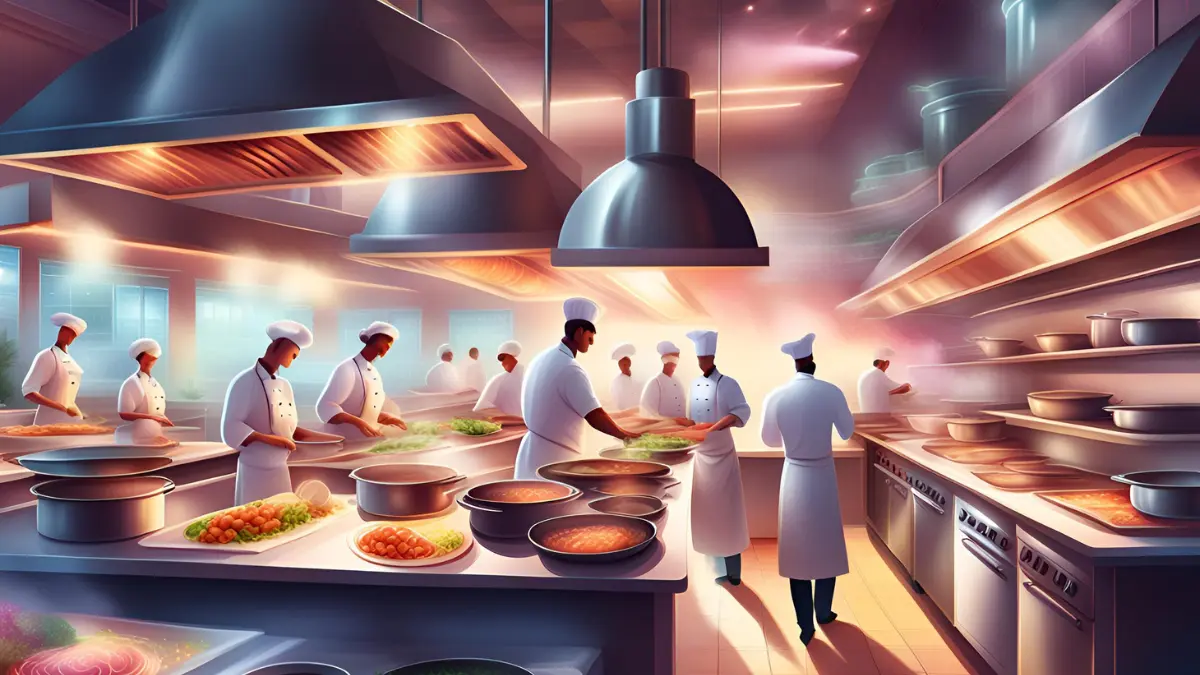Welcome to the world of food manufacturing! Have you ever wondered how your favorite foods are made? In this article, we will dive deep into the fascinating process of food production, from sourcing raw materials to distributing the final product.
Food manufacturing has come a long way since ancient times when communities developed techniques for preserving their harvests. Today, the industry has evolved to meet the demands of a rapidly growing population, producing a wide range of food products.
The food manufacturing process involves several key steps, each playing a crucial role in ensuring the safety, quality, and consistency of the final product. These steps include raw material sourcing, pre-processing, processing, packaging, quality control, and distribution.
Throughout this article, we will explore the history of food manufacturing, the different sectors within the industry, and the importance of good manufacturing practices (GMPs) in ensuring food safety. We will also discuss food manufacturing tips and tricks and the role of technology in streamlining the process.
Whether you’re a food enthusiast, a professional in the industry, or simply curious about how your favorite foods are made, this article will provide you with valuable insights into the world of food production. So let’s delve into the fascinating journey of how food is made!
Key Takeaways
|
Table of Content:
Table of Content

The History of Food Manufacturing
Food manufacturing has a long and fascinating history that can be traced back to ancient times. It all began with the need to preserve harvests and transform raw materials into usable products. Back then, communities developed techniques to ensure their survival and clothing needs by preserving food and converting raw materials into apparel.
However, it was during the Industrial Revolution that the food manufacturing industry truly evolved. With the rise of large-scale sugar plantations and the development of meatpacking factories, food production techniques advanced significantly. These advancements revolutionized the industry by increasing production capacity and creating food products with longer shelf lives.
This industrialization of food production addressed the growing demands of urban populations. It enabled the mass production of food items, allowing for greater accessibility and affordability. As a result, people had access to a wider variety of food products than ever before.
Today, the food manufacturing industry encompasses various sectors, each specializing in a specific type of product. This includes meat processing, dairy products, baked goods, beverages, and more. The industry has been shaped by centuries of innovation and continues to adapt to meet the needs of modern consumers.
The Food Manufacturing Process
The food manufacturing process involves several crucial steps to ensure safe and high-quality food products, meet consumer demands, and maintain industry integrity. It begins with raw material sourcing, obtaining ingredients from reputable suppliers or farms, and ensuring their quality and safety. Pre-processing then involves cleaning, sorting, and preparing the ingredients to remove impurities and ready them for production.
During the processing stage, methods like cooking, baking, or fermenting transform raw materials into the final product with the desired flavor, texture, and appearance. The packaging then protects the product from contamination and extends its shelf life, ensuring safety during transportation and storage. Throughout the entire process, quality control measures, including regular testing and inspections, are implemented to maintain consistent product quality.
Finally, efficient distribution channels ensure that the finished products reach retailers, wholesalers, or directly to consumers promptly. Various equipment, such as mixing machines, ovens, refrigeration units, and packaging machines, are used to streamline production, improve efficiency, and maintain consistency. By following these steps and using the right equipment, companies can meet consumer demands and contribute to the thriving food industry.
Food Manufacturing Industries
The food manufacturing industry encompasses a wide range of sectors, each specializing in the production of different types of food and beverage products. These sectors include:
Meat Processing
In the meat processing sector, various types of meat products, such as sausages and deli meats, are prepared and packaged for consumption.
Dairy Products
The dairy products sector focuses on the production of milk, cheese, yogurt, and other dairy-based items.
Baked Goods
In dedicated facilities, the baked goods sector creates a variety of delicious treats, including bread, pastries, and cakes.
Snack Foods
Snack foods, such as chips and cookies, have their separate processing methods and facilities.
Beverages
The beverage sector involves the manufacturing processes for soft drinks, juices, and alcoholic beverages.
Confectionery
The confectionery sector specializes in the production of sweets and treats, such as chocolates and candies.
Frozen Foods
Frozen foods, including ready-to-eat meals and ice cream, are produced to maintain freshness and extend shelf life.
Canned Foods
The canned foods sector focuses on preserving various types of food items, such as fruits, vegetables, and soups, in cans or jars.
Tips and Tricks for Food Manufacturing
To succeed in the competitive food manufacturing industry, it is important to stay ahead of the curve and implement effective strategies to optimize your operations. Here are some valuable tips and tricks to consider:
1. Embrace Automation for Increased Efficiency
Integrating automation into your food manufacturing processes can significantly improve efficiency, reduce human error, and save time. By automating repetitive tasks such as ingredient weighing and packaging, you can increase productivity and minimize waste. Invest in state-of-the-art food manufacturing equipment that is capable of integrating automation seamlessly.
2. Implement Lean Manufacturing Principles
Reduce waste in your food production by adopting lean manufacturing principles. This involves analyzing your production workflow to identify and eliminate any non-value-added processes or materials. Streamline your processes, optimize your inventory management, and implement just-in-time production to minimize waste and improve efficiency.
3. Prioritize Food Safety and Quality Control
Ensure that your food manufacturing processes adhere to strict food safety regulations and industry standards. Implement a robust quality control system that includes regular inspections, testing, and thorough documentation. This will help you maintain the highest standards of safety and quality throughout your production line.
4. Optimize Packaging to Reduce Waste
Explore sustainable packaging options that minimize waste and have less impact on the environment. Consider lightweight packaging materials and design packaging that is easy to recycle. Additionally, ensure that your packaging is properly sized to reduce excess material usage and transportation costs.
5. Foster a Culture of Continuous Improvement
Encourage your employees to actively participate in process improvement initiatives. Implement a system of regular feedback and performance tracking to identify areas of improvement. By fostering a culture of continuous improvement, you can achieve long-term success and stay ahead of the competition.
By implementing these tips and tricks in your food manufacturing operations, you can enhance efficiency, reduce waste, and maintain high standards of quality and safety. Embracing automation, implementing lean manufacturing practices, prioritizing food safety, optimizing packaging, and fostering continuous improvement will enable you to thrive in the dynamic and ever-evolving food manufacturing industry.
While discussing the myriad aspects of food manufacturing, it’s crucial to address specific sectors where safety and quality are paramount, such as seafood. Innovations like using empowered water in processing steps have shown promising results in preventing seafood contamination, a testament to the ongoing advancements aimed at maintaining the utmost standards of food safety.
GMPs in Food Manufacturing
Good Manufacturing Practices (GMPs) are crucial for ensuring the safety, quality, and consistency of food products. These guidelines, set by regulatory agencies, enforce compliance with food safety standards and protect consumers from health risks.
GMPs cover various aspects of food manufacturing:
- Equipment and Facilities: Guidelines for maintenance, cleaning, and proper use to prevent contamination.
- Personnel Training: Emphasizes employee training in hygiene, safety protocols, and regulatory compliance.
- Production Processes: Procedures for handling raw materials, processing, packaging, labeling, and storage to ensure consistency and minimize contamination.
- Raw Materials: Ensures high-quality sourcing, inspection, testing, and storage of raw materials.
- Cleaning and Sanitation: Protocols for regular cleaning and sanitization of equipment and facilities.
- Quality Control: Measures for testing and analyzing products to meet quality and safety standards.
- Recordkeeping: Documentation of processes, quality control, raw materials, and training for traceability and regulatory inspections.
Following GMPs is essential for maintaining high quality and safety in food manufacturing, building consumer trust, reducing risks, and consistently delivering safe and quality food products to the market.
Food Manufacturing Software
When it comes to managing the complexities of the food manufacturing process, having the right tools is essential. That’s where food manufacturing software, also known as food ERP software, comes into play. This specialized software is designed to streamline and automate various aspects of food manufacturing, making it easier to manage production planning, inventory management, and other critical processes.
One of the key features of food manufacturing software is production planning and scheduling. With this functionality, you can effectively plan and allocate resources to ensure efficient production processes. By optimizing the use of equipment, labor, and raw materials, you can reduce downtime and maximize productivity.
Another important aspect of food manufacturing software is the recipe and bill of materials management. This feature allows you to create and manage recipes for your food products, ensuring accurate ingredient quantities and efficient production workflows. With real-time visibility into your recipes and bill of materials, you can easily track inventory levels and manage ingredient substitutions.
Inventory management is also a crucial component of food manufacturing software. With the ability to track inventory levels, monitor expiration dates, and automate reorder points, you can ensure optimal stock levels and minimize waste. This not only helps you improve efficiency but also ensures compliance with food safety regulations.
What is Food Production?
Food production is a complex process that involves transforming raw materials into ready-made food products for human consumption. It encompasses various stages, from cleaning and sorting to packing, preparing, adding ingredients, and presenting the final product. The food industry plays a critical role in food production, encompassing sectors such as cultivation, harvesting, preserving, baking, butchering, fermenting, and restaurant operations.
The food industry is a vital component of the overall food production process. It involves the cultivation of crops, raising livestock, and harvesting raw materials necessary for food manufacturing. Food processing, which includes techniques such as canning, freezing, drying, and fermenting, is also a key aspect of the food industry. Additionally, the hospitality industry, which includes restaurants, hotels, and catering services, is an integral part of the food production process.
Food production is driven by the need to meet the demands of a growing population. It strives to ensure that food is safe, of high quality, and readily available for consumers. By employing proper hygiene practices, strict quality control measures, and adhering to food safety regulations, the food industry is committed to delivering safe and nutritious food products to the market.
As food production continues to evolve, technological advancements and automation play an increasingly significant role. These innovations optimize processes, improve efficiency, and reduce the risk of contamination during food production. By implementing cutting-edge technology, the food industry can enhance productivity, streamline operations, and meet the ever-changing demands of consumers.
The Hospitality Industry and Food Production
The hospitality industry, which includes lodging, tourism, and food and beverage services, is closely connected to the food production process. Within the hospitality industry, food production involves various activities, including cooking, cleaning, managing, and inventing new recipes. Education and training play a critical role in developing skills and knowledge in this industry. The food and beverage sector is one of the major contributors to the hospitality industry, providing a wide range of ready-made food options through hotels, catering services, and event organizations.
The seamless integration of food production within the hospitality industry ensures that guests and customers receive high-quality food and beverage services. Whether it’s a hotel restaurant, a catering company, or a café, food production plays a vital role in meeting the culinary needs and desires of customers.
Restaurants and hotels within the hospitality industry are responsible for producing a diverse array of dining experiences, ranging from casual dining to fine dining, and everything in between. These establishments must adhere to strict food safety regulations and maintain high standards of cleanliness and hygiene in their kitchens.
Furthermore, the hospitality industry constantly strives to innovate and create unique dining experiences. Chefs and culinary professionals within this industry are continuously experimenting with new recipes, ingredients, and cooking techniques, pushing the boundaries of food production and offering customers unforgettable gastronomic experiences.
The collaboration between the hospitality industry and food production is of utmost importance in meeting customer expectations and creating memorable experiences. It ensures that guests and customers are provided with delicious, safe, and high-quality food and beverage options during their stay or visit.
Introduction to the Kitchen
The kitchen is the central space where food production takes place. It plays a crucial role in the overall food manufacturing process. Equipped with the necessary tools and equipment for cooking and food preparation, the kitchen is where culinary creativity comes to life. It is here that the magic happens, as ingredients are transformed into delicious and satisfying meals.
The chef is the key figure in the kitchen, responsible for managing the entire operation and overseeing the cooking process. From planning menus to executing recipes, the chef brings expertise and culinary artistry to the table. Their role is to ensure that every dish meets the highest standards of taste, presentation, and quality.
The kitchen consists of various units, each serving a specific purpose. The ingredient selection unit focuses on sourcing the freshest and highest-quality ingredients. Next, the food preparation unit handles the cleaning, cutting, and cooking of the ingredients. The plating and presentation unit takes care of arranging the food attractively on plates, ensuring that every dish looks appetizing.
Food safety guidelines and personal hygiene practices are of utmost importance in the kitchen. Following strict food safety protocols helps prevent foodborne illnesses while maintaining personal hygiene standards ensures the safety and quality of the food being prepared. By adhering to these guidelines, individuals in the kitchen can create a safe and clean environment for food production.
Conclusion
In conclusion, food manufacturing is a cornerstone of modern society, ensuring the availability of a diverse range of high-quality food products. From the historical evolution of preservation techniques to the sophisticated industrial processes of today, food manufacturing has continuously adapted to meet the demands of a growing population.
The benefits of food manufacturing are manifold, including enhanced food safety, consistent product quality, and increased efficiency through automation and technology. These advancements not only streamline production but also improve traceability, allowing consumers to trust the origins and safety of their food.
For businesses looking to optimize their food manufacturing processes, HashMicro offers cutting-edge solutions designed to enhance efficiency and ensure compliance with the highest standards. Experience the future of food manufacturing with HashMicro’s comprehensive software suite. Discover how our technology can transform your operations by trying a free demo today. Embrace innovation and elevate your food production capabilities with HashMicro.





































